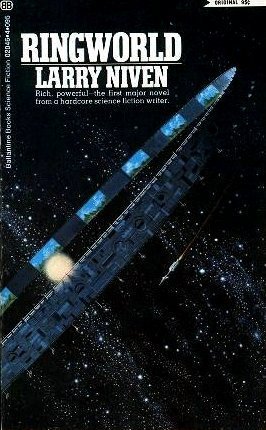Paul Gilster's Blog, page 181
March 27, 2015
SETI Explores the Near-Infrared
This has been a week devoted to extraterrestrial technologies and the hope that, if they exist, we can find them. Large constructions like Dyson spheres, and associated activities like asteroid mining on the scale an advanced civilization might use to make them, all factor into the mix, and as we’ve seen, so do starships imagined in a wide variety of propulsion systems and designs. Dysonian SETI, as it is called, takes us into the realm of the hugely speculative, but hopes through sifting our abundant astronomical data to find evidence of distant engineering.
This effort is visible in projects like the Glimpsing Heat from Alien Technologies (G-HAT) SETI program, which proceeds in the capable hands of Jason Wright and colleagues Steinn Sigurðsson and Matthew Povich at Penn State (see Wright’s Glimpsing Heat from Alien Technologies essay in these pages as well as his AstroWright blog). For those wanting to follow up these ideas, an excellent introduction is the paper “Dysonian Approach to SETI: A Fruitful Middle Ground?”, which ran in JBIS in 2011 (Vol. 64, pp. 156-165). It’s not, unfortunately, available online, though the British Interplanetary Society offers a print copy of the entire back issue here.
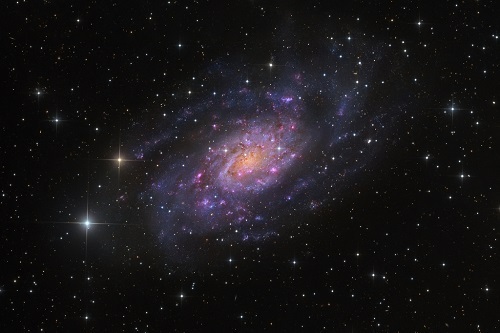
Image: NGC 2403 in Camelopardalis. Dysonian SETI, not limited to relatively nearby stars, looks for signs of astroengineering not just in our own but in distant galaxies like this one, some ten million light years away.. Credit & Copyright: Martin Pugh.
Into the Infrared
The more conventional radio and optical SETI methods continue as well. I’ve written often in these pages about Frank Drake’s Project Ozma at the Green Bank (WV) site, and cited the classic 1959 paper “Searching for Interstellar Communications” by Giuseppe Cocconi and Philip Morrison, which more or less opened up the entire field. But equally significant is Charles Townes’ 1961 paper “Interstellar and Interplanetary Communication by Optical Masers,” which ran in Nature (Vol. 190, No. 4772, pp. 205-208), from which this quote:
We propose to examine the possibility of broadcasting an optical beam from a planet associated with a star some few or some tens of light-years away at sufficient power-levels to establish communications with the Earth. There is some chance that such broadcasts from another society approximately as advanced as we are could be adequately detected by present telescopes and spectrographs, and appropriate techniques now available for detection will be discussed. Communication between planets within our own stellar system by beams from optical masers appears a fortiori quite practical.
Townes, who died recently, built the first maser, which worked primarily in the microwave region of the spectrum. He was a major figure in the development of both maser and laser technologies, and a winner of the Nobel Prize in 1964. The field of optical SETI has not been as visible as the older radio SETI but its proponents are actively pursuing the search at sites like Lick Observatory, where the 1-meter Nickel Telescope has been equipped with a new pulse-detection system using three light detectors, an installation that allows what Frank Drake calls “…perhaps the most sensitive optical SETI search yet undertaken.”
The new instrument is called NIROSETI, which stands for near-infrared optical SETI. It promises to gather copious data by recording levels of light over time to look for patterns that might signify a distant civilization. The beauty of working at near-infrared wavelengths is that such light penetrates much farther through gas and dust than visible light, helping us widen the search to stars thousands of light years away. NIROSETI saw first light on March 15.
Unlike Dysonian SETI, optical SETI operates under the premise that an extraterrestrial civilization may be trying to communicate with us, beaming light explicitly at our Solar System. According to this news release from the SETI Institute, NIROSETI’s use of three light detectors will allow the team to separate the brief pulses of light they are looking for from false alarms of the sort that have troubled other optical SETI experiments using fewer detectors. Optical SETI ‘noise’ can consist of cosmic rays, incident starlight, muon showers and radioactive decay in the glass of the photomultiplier tubes of the detectors, all events to be screened out of the data.
Dan Werthimer, who along with Richard Treffers (UC-Berkeley) designed an earlier instrument for optical SETI, notes where NIROSETI departs from its predecessors:
“This is the first time Earthlings have looked at the universe at infrared wavelengths with nanosecond time scales. The instrument could discover new astrophysical phenomena, or perhaps answer the question of whether we are alone.”
Shelley Wright (UC-San Diego) led the development of the new instrument while at the University of Toronto, finally signing off on detectors sensitive enough to deploy on the telescope. In addition to Wright and Werthimer, the group also includes Geoff Marcy and Andrew Siemion (UC-Berkeley), Patrick Dorval and Elliot Meyer (University of Toronto) and pioneering SETI scientist Frank Drake, whose take on the investigation is determinedly optimistic:
“There is only one downside: the extraterrestrials would need to be transmitting their signals in our direction. If we get a signal from someone who’s aiming for us, it could mean there’s altruism in the universe. I like that idea. If they want to be friendly, that’s who we will find.”
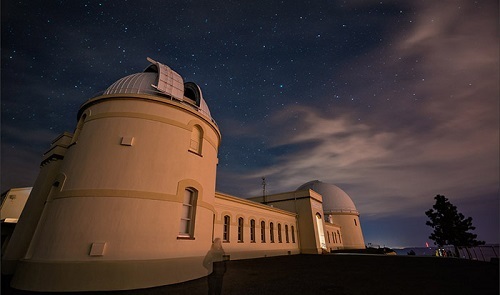
Image: Skies cleared for a successful first night for NIROSETI at Lick Observatory. The ghost image is Shelley Wright, pausing for a moment during this long exposure as the rest of her team continued to test the new instrument inside the dome. Credit: UC-San Diego.
We can hope that Frank Drake’s ideas come to pass. In any event, it’s clear that the definition of SETI is evolving as we continue to explore radio, optical and Dysonian strategies. In my view, the emergence of the Dysonian approach has been a genuine boon for our investigations. It reminds us how much astronomical data we have accumulated that can now be subjected to analysis in these terms. Will evidence of the existence of an extraterrestrial civilization come, if it does come, through a radio burst, an optical signal, or the observation of an anomaly in a distant galaxy?





March 26, 2015
Starship Detection: The K2 Perspective
‘Classical’ SETI, if I can use that term, is based on studying the electromagnetic spectrum primarily in the radio wavelengths thought most likely to be used for communication by an extraterrestrial civilization. SETI’s optical component is largely focused on searching for signals intended as communication. What is now being called Dysonian SETI is a different approach, one based on gathering observational evidence that may already be in our archives, data that demonstrate the existence of extraterrestrial activity far beyond our capability.
Just as a Dyson Sphere would reveal the workings of a civilization of Kardashev Type II — producing something like ten billion times the energy of a Type I culture — the detection of a starship would show us technology in action, even if the craft were, as Ulvi Yurtsever and Steven Wilkinson have speculated, a vehicle pushing up against light speed millions of light years away. As physicist Al Jackson has tackled starship detection in recent years, he has taken note of the work of D. R. J. Viewing and Robert Zubrin, which dealt with some but not all design and detection possibilities. Beamed propulsion, for example, does not turn up in these sources.
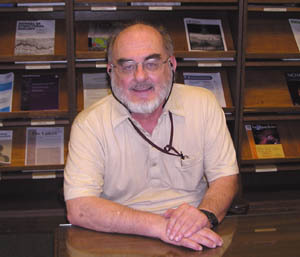
Jackson also points to a caveat in such work: If we are hoping to detect a starship using many of the methods described in previous studies, we need to be inside the engine’s exhaust cone or the transmitter cone of the energy beam. We also know that the cone will be narrow. Even so, there are a number of ways to proceed, ranging from the craft’s interactions with the interstellar medium to detection of its own waste heat.
Image: Physicist Al Jackson. I can’t remember who took this (it may even have been me).
Imagine a highly advanced ship built by a Kardashev Type II civilization. Give it a gamma factor of 500, which translates to 0.999998 times the speed of light. Assume the ship is as hot as 5000 K (near the melting temperature of graphene). All these are extreme assumptions (see below) but we’re pushing the envelope here. This is, after all, K2.
Would we be able to detect such a craft? Waste heat can be modeled as isotropic radiation, says Jackson, in the rest frame of the ship, while to an observer in another inertial frame, this radiation appears beamed. We get this result:
Considering a ship of modest size and mass, a K2 ship accelerating at one gravity. For instance, if we have a ship 1000 meters long and 50 meters in diameter, generating 11402 terawatts in its rest frame, Doppler boosting will generate approximately 1.2×108 terawatts beamed into the forward direction. However… unless the ship is headed straight at the observer, it will be hard to see. Take into account the Doppler shifting of the characteristic wavelength, from near green in the rest frame to soft x-ray in the observer’s frame. One might look for small anomalies in data from a host of new astrophysical satellite observatories.
Not very encouraging, but then, detecting the signature of a starship is not going to be easy. One possible place to look is in the realm of what Jackson calls ‘gravitational machines,’ such as the massive binaries Freeman Dyson once suggested could be used as gravitational slingshots. We might consider not just white dwarf and neutron star binaries but even black hole binaries. A gravitational assist in such scenarios might reach as high as .006c.
On the other hand, wouldn’t a civilization that could already reach binaries like these have acquired capabilities greater than those it would gain by using the binaries in the first place? Perhaps better to consider black holes as a source of direction change for fast-moving starships. Jackson points out that a starship orbiting a black hole will have visible waste radiation. In fact, a close-orbiting ship will have fluctuating emissions peaked at those times that the ship, black hole and observer line up, a phenomenon that is the result of gravitational focusing.
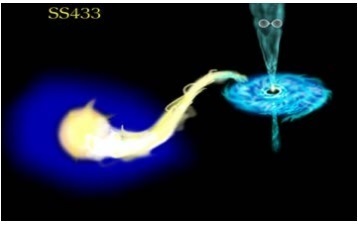
Other extreme astronomical objects may be worthy of investigation in these terms. Jackson points to SS 433, a neutron star or black hole orbited by a companion star, with material being drawn from the companion into an accretion disk. Jets of particles are being blown outward from the poles. While at SS 433 the particles in the jets are moving at 26 percent of the speed of light, jet material in configurations like these can reach 95 percent of lightspeed. Using such jets to propel magsails that reach .5 times the speed of light would allow a K2 civilization an abundant source of energy for repeated missions at a high percentage of c.
Image: Magsail ‘jet riding’. Credit: Doug Potter.
We don’t know what a K2 civilization will choose to do, but exploiting naturally occurring resources like these may be an attractive proposition. There may be interesting prospects not just for magsails but so-called ‘lightsails’ around extreme astronomical objects:
Consider a K2 civilization taking advantage of a Schwarzschild or Kerr black hole as a means of focusing radiation from a beaming station onto a sail. The advantage of this is the tremendous amount of amplification possible. One of the most promising modes of interstellar flight propulsion is the use of a sail, a transmitter, and maybe a ‘lens’ to focus a beam of laser light or microwaves. Extrapolate to a K2 civilization the use of a black hole as the focusing device. An approximate calculation for a Schwarzschild black hole shows that beamed radiation can be amplified by a factor 105 to 1015.
So-called ‘strong focusing’ is tricky to model and, as Jackson explains in some detail, the astronomical configuration — the location of a source and the best location for the sail — are topics that need much more work. But the idea that a K2 civilization would use the immense energies available in the area of black holes makes them a natural hunting ground for Dysonian SETI activity. Could a black hole in the vicinity of a starship’s destination be used for braking?
Robert Bussard’s 1960 paper on interstellar ramjets posited a spacecraft that could collect gas from the interstellar medium, compressing it to a plasma that could be brought to fusion temperatures. Carl Sagan would later suggest that a magnetic scoop would be the ideal way for this gas collection to proceed, but later work by Dana Andrews and Robert Zubrin revealed how much drag such a magnetic scoop would produce. The ‘magsail’ actually acts like a brake.
Why not, then, use these magsail properties, shedding energy and momentum as a spacecraft nears its destination? Craft moving at relativistic velocities might find this an efficient way to arrive, one that produces a ‘bow shock’ whose radiation ranges from the optical to the X-ray bands. “A starship will be much smaller than a neutron star,” writes Jackson, “but detection of the radiation signature of a starship’s bow shock could imply a very peculiar object.”
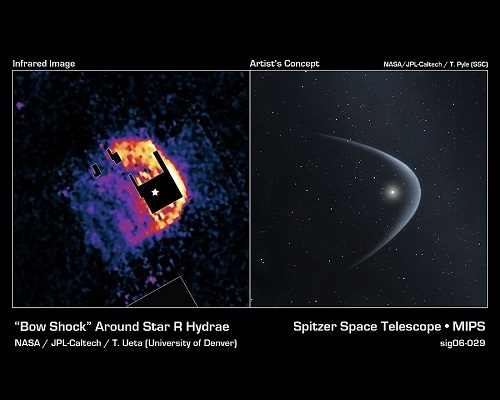
Image: Two examples of neutron star bow shock, the one on the right an artist’s concept. Credit: Wikimedia Commons.
Jackson’s paper is a work in progress, with an early version printed in Horizons, the AIAA bulletin for the organization’s Houston chapter. A journal submission is in the works as he refines the draft. It’s a fascinating discussion that reminds us how much we have to speculate about when we talk K2 civilizations. Jackson notes the major assumptions: Ships can run ‘hot,’ and that means as high as 5000 K; material structural strength limits have been overcome; extreme accelerations are allowable and dust/gas shielding issues resolved. We can argue about the limits here, but it’s clear that a K2 civilization will have capabilities far beyond our science, and it may be the random anomaly in astronomical data that flags its existence.





March 25, 2015
Our View of a Decelerating Magsail
Yesterday’s post looked at the question of starship detection. But the paper by Ulvi Yurtsever and Steven Wilkinson that I discussed actually focused on a highly specific subset of such observations, the case of an artificial object moving at such high gamma factors that the ship’s velocity was over 99 percent of the speed of light. It may be that such things become possible to sufficiently advanced civilizations, but if they do and we observe them, we will be doing something akin to what Richard Carrigan does when he looks for Dyson spheres. Hunting a relativistic starship between galaxies is a kind of interstellar archaeology.
What I mean is that if any of the researchers now looking for observational data of advanced civilizations turn something up in, say, M31, that construct will be so far away from us in both space and time that we might well be studying the ruins of an ancient culture. I made this case not long ago in an essay called Distant Ruins for Aeon magazine. This is a different kind of SETI, one in which communication is almost certainly not an issue, just as would be the case if we detected the signature of a starship in the intergalactic deep.
Science fiction that looks at starship detection usually takes a more active stance. In Arthur C. Clarke’s wonderful Rendezvous with Rama (1973), it is an early warning system to detect dangerous asteroids that initially notices the starship humans will name Rama. Further observations help nail down a trajectory that comes from interstellar space and will return there, while the detection of a rapid rotation and, later, photographs of the object as a perfect cylinder make it clear that this will be our species’ first encounter with an alien vessel.
And then there’s The Mote in God’s Eye by Larry Niven and Jerry Pournelle, published the following year, in which astronomers detect a starship in the form of a laser-beamed lightsail. It’s an older technology in the world of the novel, for in this future scenario humans have already produced a star drive that eclipses the much slower sail method. Observed changes in the brightness and color of a Sun-like star in a binary system (the star is called the Mote for reasons explained in the novel) turn out to have been caused by the operation of the laser system beaming the craft toward the Earth.
Here the scene is the bridge of a human starship as the crew discusses the observations that lead to the discovery that they are dealing with an alien technology, specifically its laser beaming system:
“…I checked with Commander Sinclair. He says his grandfather told him the Mote was once brighter than Murcheson’s Eye [the other star in the binary pair], and bright green. And the way Gavin’s describing that holo – well, sir, stars don’t radiate all one color. So -”
“All the more reason to think the holo was retouched. But it is funny, with that intruder coming straight out of the Mote…”
“Light,” Potter said firmly.
“Light sail!” Rod shouted in sudden realization…”
Niven and Pournelle had vetted their lightsail concept with Robert Forward at a time when the idea was just gaining traction thanks to the latter’s work in the journals.
In both novels, the starship detection has huge consequences for our species as the craft in question is entering human space. When I went back and looked at Robert Zubrin’s 1995 paper on starship detection, I remembered that he came up with interesting figures for different kinds of starships. An antimatter photon rocket would produce gamma ray emissions that would be undetectable at visual wavelengths, but Zubrin found that based on his assumptions on an arbitrarily chosen 1,000,000 ton craft, an exhaust with an effective irradiated power of 1,800,000 TW would be produced. He went on to describe its detectability:
Such an object at a distance of 1 light-year would be seen from Earth as a 17th magnitude light source, and could be detected on film by a first class amateur telescope. The 200 inch telescope on Mount Palomar could image it at 20 light years, and the Hubble Space Telescope at a distance of about 300 light years… Since at least for the upper-end telescopes considered, the number of stellar systems within range is significant (100,000 stars are within 200 light years of Earth) this approach offers some hope for a successful search. The light from the photon rocket could be distinguished from that of a dim star by the lack of hydrogen lines in the rocket’s emissions.
Here again we’re dealing with a vast volume of space but a distance of no more than 200 light years in any direction. But beyond the visual spectrum, Zubrin discusses a variety of scenarios, noting that radio waves may be emitted from a starship due to plasma interactions with the deceleration field of a magnetic sail, or the confinement field of a plasma drive engine. Now the detection distances grow greater. The plasma drive engine‘s electron and ion cyclotron radiation could be detected on the ground by radio telescopes. Magsails produce electron cyclotron radiation with frequencies of tens of kHz and ion cyclotron radiation with frequencies of tens of Hz. No ground detection here, but the magsail radiation would be apparent to receivers of sufficient size working outside the Earth’s atmosphere.
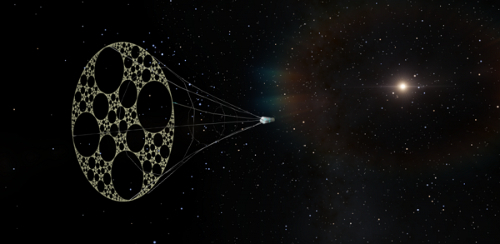
Image: One configuration of a magsail as envisioned by Steve Bowers on the Orion’s Arm site. This design uses multiple superconducting loops for maximum braking effect against the interstellar medium. Credit: Steve Bowers.
The low frequency magsail radiation is made to order for large antennae in space, making it the easiest starship configuration to detect:
It can be seen that the magsail radiation of a characteristic fusion starship being decelerated from a cruise velocity of 0.1c could be detected by a 6 km orbiting antenna from a distance of 400 light years, while that emitted by a characteristic antimatter photon rocket in its deceleration phase could be seen as far away as 2,000 light years. There are about 100,000,000 stellar systems to be found within the latter distance. This extended range detection capability combined with magsail radiation’s unique time-dependent frequency spectrum appears to make a search for magsail radiation the most promising option for extraterrestrial starship detection.
As mentioned yesterday, Al Jackson has been considering the question of starship detectability for some time, and in mid-2014 published a preliminary paper on the matter describing his findings. It’s Jackson’s work that, even more than Yurtsever and Wilkinson, pushes the boundaries of speculation the furthest, or as Al puts it in the paper, “…the methods used to attain relativistic speed, using high-energy astrophysical processes, are far out in the tail of the distribution of speculation…” And he adds this tantalizing thought: “Is there a ‘Wow!’ signal lurking in the non-standard parts of the SETI electromagnetic spectrum? Starships braking in a dense interstellar region are attractive possible observations.”
Tomorrow I want to look at some of these speculative starship ideas and the kind of signatures they might throw, as per Jackson’s paper. For today, the Zubrin paper is “Detection of Extraterrestrial Civilizations via the Spectral Signature of Advanced Interstellar Spacecraft,” Progress in the Search for Extraterrestrial Life, ASP Conference Series Vol. 74 (1995). Available online.





March 24, 2015
Starship Observational Signatures
Now and again in relatively rarefied SETI discussions the topic of starship detection comes up. Specifically, if there were a starship moving through the interstellar medium in the general vicinity of our perch in the Orion Arm, would we be able to detect any sort of signature in our astronomical data? Centauri Dreams regular Al Jackson has looked into this for a variety of starship types (and discussed the matter at Starship Congress in 2013), and so has Gregory Benford, whose 2006 novelette “Bow Shock” describes the detection of an object whose synchrotron radiation fits the signature of the bow shock of a craft something like a Bussard ramjet.
We also have a 1995 paper from Robert Zubrin on the spectral signatures of starships and, back in 1977, a JBIS paper by D. R. J. Viewing and colleagues on relativistic spacecraft detection. Various detection methods come to mind, but Al Jackson has pointed out that the simplest would be finding the signature of waste heat (see SETI: Starship Radiation Signatures). A common theme in these discussions is to look for starships moving in the interstellar medium and try to identify interactions between that medium and the ship.
The choice makes sense, for we’ve looked on many occasions at what happens as we move swiftly between the stars. The designers of Project Daedalus knew that at 12 percent of the speed of light, some kind of shielding would be a good idea to protect the craft from interstellar dust particles and larger objects. And a new paper from Ulvi Yurtsever and Steven Wilkinson (Raytheon Company) gives us further information. Get your spacecraft moving fast enough and you’re dealing with collisions like those in particle accelerators but at much higher energies.
Into the Intergalactic Deep
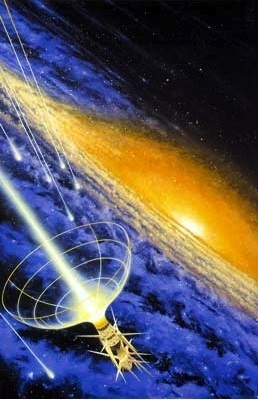
Relativistic effects can be described through the Lorentz factor, cited as γ (gamma) in the relevant equations. Gamma depends upon the speed at which an object is moving. We don’t see length contraction and time dilation in our everyday lives because we don’t move fast enough to notice them, but gamma increases exponentially as we approach the speed of light even though it is all but negligible at lower speeds. A spacecraft moving at 25 percent of lightspeed, for example, has a gamma of just 1.03, meaning time or length contraction of no more than 3 percent.
That gamma factor may be low, but even this speed is high enough to cause serious problems for a starship moving through interstellar dust, and as we go higher, the situation rapidly worsens. At a gamma factor of 2, our craft is moving at 86 percent of the speed of light. Now an object the size of a baseball with mass of 150 grams, note Yurtsever and Wilkinson, has an impact energy of 36 megatons. The authors define ‘extreme velocities’ as those with gamma greater than 9.1, which is well over 99 percent of the speed of light. Here we are in the range of the kind of proton/proton collisions used in particle accelerators to produce antiprotons.
The authors see no safe speeds in the interstellar medium greater than a gamma of 1.3, which is still more than 60 percent of the speed of light. Even the latter seems much too high: Shielding systems to protect a craft moving through the interstellar medium at 60 percent of c are well beyond anything I’ve ever seen discussed. But where the new paper really moves beyond earlier work is in its choice of destinations. What if an advanced civilization were to travel through not interstellar but intergalactic space? Here there is much less debris per unit volume and the chances of collision are sharply reduced. The interactions in question are with photons from the cosmic microwave background (CMB) as the craft moves close to c. From the paper:
The possibility of detecting radiation associated with distant relativistic spacecraft has been discussed in the literature before. These discussions mostly focus on detecting radiation from spacecraft engines or light from nearby stars reflecting off the spacecraft. Our approach is different in that we do not speculate on possible propulsion technologies but are interested in how a large relativistic object would interact with the interstellar/intergalactic medium and mainly with the CMB radiation. As a baryonic spacecraft travels at relativistic speeds it will interact with the CMB through scattering to cause a frequency shift that could be detectable on Earth with current technology.
Collisions with photons from the cosmic microwave background will appear in the spacecraft frame as highly energetic gamma rays. The paper assumes that a technology capable of reaching these speeds will be able to handle the effects of ionization and other interactions, but pair production is likely still an issue. Here we are looking at interactions between photons and matter in the hull of the spacecraft, with a single CMB photon creating an electron-positron pair when it collides with a nucleus in the hull, producing a characteristic signature. The paper looks at two special reference frames, the spacecraft frame and the rest frame of the cosmic microwave background, to understand how the CMB is distorted from these viewpoints.
The starship’s interactions with the CMB photons should produce a unique signature. The paper notes that the effect of CMB scattering from macroscopic relativistic objects like starships is similar to the Sunyaev-Zel’dovich effect in cosmology, in which low-energy CMB photons receive an energy boost when they collide with high energy electrons. The effects of this distortion of the cosmic microwave background have been used by cosmologists to study density perturbations in the universe and have been applied to the study of galactic clusters.
We don’t know if any civilization will learn how to travel at the kind of gamma factors discussed here, which take us well above 99 percent of the speed of light, but if a civilization is able to build spacecraft that can move this fast, they will have solved the problems of matter interactions that are much like those that occur in particle accelerators. The kind of technologies used would be well beyond our understanding but perhaps not beyond our detection. The paper concludes:
Our calculation for what an observer on earth could detect predicts a very unusual signature that is unlikely to be caused by any naturally occurring object in the known universe. This result is independent of propulsion technology, but the ability to detect the signal from Earth depends on available detector technologies. We are currently working to predict how far can we see this signature given our current capability.
The paper is Yurtsever and Wilkinson, “Limits and Signatures of Relativistic Spaceflight,” now available on the arXiv site.





March 23, 2015
White Dwarfs and Dyson Spheres
There is a wonderful moment in Larry Niven’s 1970 novel Ringworld when protagonist Louis Wu is first shown an image of an artificial ring completely encircling a star. These days the concept of a Dyson sphere is well established as a way for a civilization to capture as much energy as possible from the host star, but back then I had never heard of the concept. Dyson thought both a solid shell and a ring would be unstable and believed the best form for his concept was what he described as “…a loose collection or swarm of objects traveling on independent orbits around the star.” In that sense, Niven’s Ringworld wasn’t really Dysonian, but I found it staggering.
What a place! An engineered ring the diameter of Earth’s orbit fully 1.6 million kilometers wide, giving a habitable inner surface equal to about three million Earth-sized planets. A broader backdrop for science fiction adventure could scarcely be imagined unless it were a full-blown Dyson sphere. And indeed, Ringworld became the venue for a number of subsequent novels that tied into the collection of futuristic lore Niven called Known Space.
Speaking of science fiction authors reminds me that Dyson himself harked back to Olaf Stapledon, whose 1937 novel Star Maker seems to have given him his inspiration. In fact, Dyson has opined (I believe this was at the Starship Century symposium in San Diego) that ‘Stapledon sphere’ would be a more accurate name for the idea. Here’s Stapledon’s original read on Dyson spheres as a common outcome in a galaxy, viewed by the visionary protagonist as he witnesses events of the far future, when civilization “…began to avail itself of the energies of its stars upon a scale hitherto unimagined”:
“Not only was every solar system now surrounded by a gauze of light traps, which focused the escaping solar energy for intelligent use, so that the whole galaxy was dimmed, but many stars that were not suited to be suns were disintegrated, and rifled of their prodigious stores of sub-atomic energy.”
Addendum: Dyson’s talk in San Diego, which I had initially mis-reported as having been made in London, is available at the Starship Century site — click on the link to the videos.
Capturing all the power of a host star is a marker for a civilization that has reached Type II in Nikolai Kardashev’s classification of intelligent civilizations. Type III — this is what Stapledon depicts in the passage above — can tap the energy resources of its entire galaxy. Dyson Spheres would be vast indeed, but the various searches that have thus far been undertaken for them have relied on the amount of infrared radiation such an object would produce (see, among a number of articles in the archives here, Toward an Interstellar Archaeology, which talks about Richard Carrigan’s leading role in conceiving and mounting this search).
The White Dwarf Alternative
We have no Dyson sphere detections as of now, but speculative work on the concept continues, as revealed in a new paper from İbrahim Semiz and Salim Oğur (Boğaziçi University, Istanbul), forwarded to me recently by Adam Crowl. The duo posit a new take on Dyson spheres in which they are built around not G-class stars like our Sun but white dwarfs. Building around a white dwarf offers a number of possible solutions to Dyson sphere problems. And it turns out there are many of these.
Consider: If we somehow built a true sphere in the Solar System with a 1 AU radius, the gravity of the Sun would, according to the authors, be a miniscule 5 X 10-4 g. Inhabitants would be faced with microgravity. Rotating a Dyson Sphere would be one way out of the problem, but doing this would leave the equatorial regions as the truly usable surfaces, which would make it more sensible to build a ring-like structure in the first place rather than an all encompassing sphere that was largely useless. A system of independently rotating rings might be imagined but seems gratuitously complex.
The authors are aware of the instability that would plague both a Dyson sphere and a ring, but their paper isn’t about finding solutions to these problems but arguing for a different central object, which has advantages of its own. A white dwarf is much smaller than a G-class star, but applying Dysonian principles here would still give us a similar way of capturing energy while providing, by the authors’ estimate, 105 times the living area of a planet on the outside shell while not subjecting inhabitants to microgravity. A possible scenario is a civilization surviving the red giant stage of its star and returning to construct a Dyson Sphere around the white dwarf that eventually emerged.
From the paper:
…the red giant stage is also quite long, about a billion years for a solar-mass star (it decreases with mass), so it might seem that life/intelligence/civilization could also develop during that stage. However, conditions like radiative flux and stellar wind, even the mass of the star, are quite variable during the red giant phase, as opposed to the main-sequence period, when they are stable. Hence, while the astronomically-long-term outlook of an intelligent civilization is subject of conjecture, a civilization set to build a Dyson Sphere as discussed in this work would probably arise during the main sequence period of its star, and find ways to survive the red giant stage; maybe temporarily migrating to an orbit farther from its star, either to a planet, or failing/rejecting that, to orbital habitats a la O’Neill. In fact, such an effort would provide the experience needed before undertaking the construction of the Dyson Sphere around the eventual white dwarf.
We wind up with a 106 kilometer-scale Dyson Sphere with the inhabitants living on the outer shell as an alternative to the more common Dyson Sphere of fiction and speculation, one that would still be theoretically detectable through its infrared emissions but a much greater challenge because of its lower power. Its smaller size also means the white dwarf Dyson Sphere needs less construction material, with a 10-meter thick shell requiring approximately the mass of a single terrestrial planet. The required compressive strength of building materials for such a rigid sphere is also higher, demanding an extra means of support about which the authors choose not to speculate.
The paper is Semiz and Oğur, “Dyson Spheres around White Dwarfs,” available on the arXiv site as a preprint.





March 20, 2015
Large Exomoons Shown to Be Detectable
The search for sub-planetary scale features in other solar systems continues, with encouraging news from the Hunt for Exomoons with Kepler project. A moon around a distant exoplanet is a prize catch, but as we’ve also seen recently, scientists are weighing the possibilities in detecting exoplanetary ring systems (see Searching for Exoplanet Rings). Confirming either would be a major observational step, but exomoons carry the cachet of astrobiology. After all, a large moon around a gas giant in the habitable zone might well be a living world.
David Kipping (Harvard University) and colleagues at HEK have released a new study that tackles the question of how detectable exomoons really are. Published online today by the Astrophysical Journal, the paper examines 41 Kepler Objects of Interest, bringing the total number of KOIs surveyed by HEK thus far up to 57. The paper demonstrates that the process is beginning to move out of the realm of computer simulations and assumption-laden theory to actual data from Kepler. The paper’s goal is to determine how small a moon could be detected in each case given the kind of signatures that flag an exomoon’s presence.
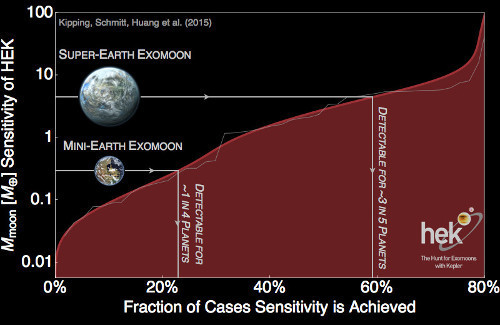
Image: After surveying nearly 60 exoplanets for moons, the HEK team have derived empirical limits for each world, demonstrating an ability to detect even the smallest moons capable of sustaining an Earth-like atmosphere (“Mini-Earths”) for 1 in 4 cases studied. Whilst a confirmed discovery remains elusive, the painstaking survey of 60 planets spanning several years reveals what is possible with current technology. Credit: The Hunt for Exomoons with Kepler (HEK) Project.
An examination of an exoplanet that does not turn up an exomoon thus leads to a statement of how massive a moon has been excluded by the current data, which means the team is learning much about the sensitivity of its methods. From the paper:
… based on empirical sensitivity limits, we show for the first time that the HEK project is sensitive to even the smallest moons capable of being Earthlike for 1 in 4 cases (after accounting for false-positives). In terms of planet-mass ratios, we find even that the Earth-Moon mass-ratio is detectable for 1 in 8 of cases, posing a challenge but not an insurmountable barrier. Mass ratios of ∼ 10−4, such as that of the Galilean satellites, have never been achieved. However, if Galilean-like satellites reside around lower-mass planets than Jupiter, of order ∼ 20 M⊕, then we do find sensitivity, as demonstrated by the limit of 1.7 Ganymede masses achieved for Kepler-10c.
This is encouraging news, for the team can now make statements about the actual mass of a detectable exomoon. In 1 of 3 planets surveyed, an exomoon with Earth’s mass is detectable. Kipping believes that we can move down to the smallest moon thought capable of supporting an Earth-like atmosphere and still detect it in 1 of 4 of the cases studied. No exomoons have yet been detected but we are learning just what our capabilities are. Says Kipping:
“Here we report on our null results and the first estimate of empirical sensitivities. Ultimately, we would like to actually discover a clear signal and are pursuing some interesting candidates we hope will pan out. Either way though, I like to recall what the Nobel Prize winning American physicist Richard Feynman said about science: ‘Nature is there and she’s going to come out the way she is, and therefore when we go to investigate it we shouldn’t pre-decide what it is we’re trying to do except to find out more about it’.”
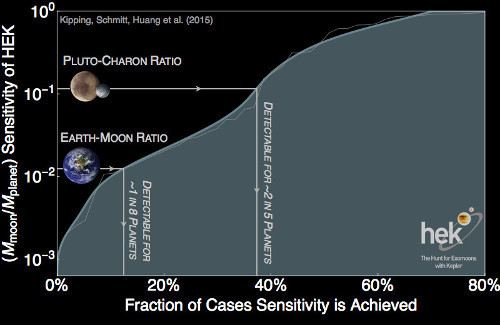
Image: The Moon has about 1% the mass of the Earth posing a challenge for the HEK team, since such configurations are detectable for 1 in 8 planets surveyed. The much larger Pluto-Charon mass-ratio of 11.6% is much more detectable. Credit: Hunt for Exomoons with Kepler Project.
No exomoons turn up in the 41 KOIs surveyed in the study, with four, KOI-0092.01, KOI-0458.01, KOI-0722.01 and KOI-1808.01, showing up as false positives for an exomoon. Stellar activity is a likely cause, as the paper comments:
When dealing with a handful of transits, quasi-periodic distortions to the transit profile, such as those due to spots… can be well fitted by the flexible exomoon model. However, since an exomoon is not the underlying cause, this model lacks any predictive power and thus should fail F2a [a follow-up test described in the paper]. We therefore suggest that stellar activity is likely responsible for these four instances.
KOI-1808.01, in fact, passes the basic criteria for an exomoon detection, but the paper explains that the observed transit signal is distorted by the effects of star spots. Transit timing variations observed at KOI-0072.01 (Kepler-10c) seem to point to an additional planet in the system rather than an exomoon.
Thirteen of the KOIs produce some kind of spurious detection, assigned by the paper to effects like perturbations from unseen bodies, stellar activity or instrumental artifacts. Through the range of KOIs the project has studied thus far (57), 46 null detections are found from which upper limits on an exomoon’s mass can be derived. The paper reminds us that “…exomoons live in the regime where correlated noise is present and one must employ methods to guard against it when seeking such signals.”
The declared purpose of the Hunt for Exomoons with Kepler project is to ‘determine the occurrence rate of large moons around viable planet hosts,’ a task with implications for the abundance of life in the universe, for if habitable moons are common, there could be more of them than habitable planets, and conceivably more than one orbiting a single planet. An additional benefit of studying exomoons is that they can teach us about solar systems formation by showing us planet/moon systems in a variety of configurations.
The paper is Kipping et al., “The Hunt for Exomoons with Kepler (HEK): V. A Survey of 41 Planetary Candidates for Exomoons,” submitted to the Astrophysical Journal (preprint).





March 19, 2015
Chariklo & Chiron: Centaurs with Possible Rings
You may be forgiven if you aren’t familiar with the name Chariklo. Discovered in 1997, 10199 Chariklo is a ‘centaur,’ an outer system body with an orbit that moves between the orbits of Saturn and Uranus, just nudging the orbit of the latter. Its odd name (we’re big on names and their derivations here) comes from a nymph who in Greek mythology was the wife of Chiron and daughter of Apollo. No centaur is larger than Chariklo (estimated diameter 250 kilometers), and until just the other day, no other centaur was known to have what Chariklo did: A system of rings.
We’ve just learned, though, that the second largest centaur, 2060 Chiron, may have a set of rings of its own, although there are alternative ways of interpreting the data. Whether Chiron’s rings are confirmed or not, what was once thought to be an unusual phenomenon, a feature of Saturn alone, is now turning out to be far more common, with rings known to orbit Jupiter, Uranus and Neptune as well as Chariklo. So we have full-scale planets with rings of various size and density, and centaurs, which have been found to share the characteristics of both comets and asteroids. There may well be more ring systems out there, as there are estimated to be 44,000 centaurs in the Solar System with a diameter larger than 1 kilometer.
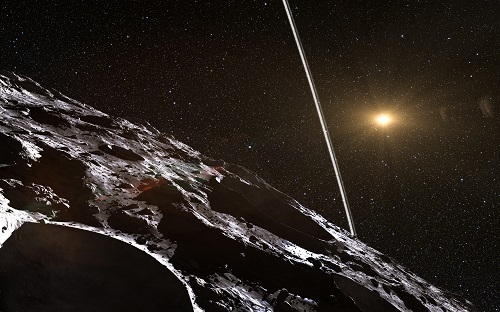
Image: An artist’s impression of the dense and narrow rings around Chariklo. The origin of these rings remains a mystery, but they may be the result of a collision that created a disc of debris. Data from a recent occultation implies that another centaur, Chiron, may also have a ring system, although other explanations are still being examined. Credit: European Southern Observatory.
The discovery of rings around Chariklo and the work on Chiron came about because of stellar occultations as the objects in question passed in front of a bright star, Chariklo in 2013 and Chiron in 2011. In both cases, the occultation produced a useful light signature for researchers studying the brief shadow. A disk of debris circling Chiron is one reading of the data from that centaur’s occultation, but we can’t rule out jets of material from the surface or even a shell of gas and dust enveloping the object. Amanda Bosh (MIT), a co-author of the paper on the discovery in the journal Icarus, calls that an intriguing result because of Chiron’s location, “…part of that middle section of the solar system, between Jupiter and Pluto, where we originally weren’t thinking things would be active, but it’s turning out things are quite active,”
Traces of activity on Chiron actually trace back to the early 1990s, when MIT’s James Elliot studied a similar stellar occultation by the centaur and was able to make estimates of its size. At that time, features in the data also implied the existence of jets of water and dust coming from the centaur’s surface. The new data, drawn from NASA’s Infrared Telescope Facility on Mauna Kea and the Las Cumbres Observatory Global Telescope Network at Haleakala, give us a more precise readings on an event that in its entirety lasted no more than a few minutes.
MIT’s Jessica Ruprecht, lead author of the paper, notes the range of possibilities involved in this work:
“If we want to make a strong case for rings around Chiron, we’ll need observations by multiple observers, distributed over a few hundred kilometers, so that we can map the ring geometry. But that alone doesn’t tell us if the rings are a temporary feature of Chiron, or a more permanent one. There’s a lot of work that needs to be done.”
According to this MIT news release, the two features observed in the data are each about 300 kilometers from the center of the object and are not dissimilar to what Elliot observed in the 1990s. These may be symmetrical jets of gas and dust rather than rings, perhaps the result of the centaur’s having moved inward from the Kuiper Belt, warming enough to turn frozen gases into jets that throw dust and other material off the surface. Ruprecht also notes that debris from a nearby object could conceivably be captured by a centaur like Chiron to produce rings. At the moment, then, we don’t know if we’re looking at a long-lasting feature or a transient event.
Back to Chariklo, whose stellar occultation in 2013 revealed the existence of two rings, one about 3 kilometers and the other about 7 kilometers wide, separated by about 9 kilometers. The find was startling because no previous ring systems around minor bodies had been discovered, and there were questions about how stable a ring system could be around such a small object. The two rings have received nicknames (Olapoque for the larger, Chui for the smaller) derived from the names of rivers in Brazil, but the IAU will at some point confer official names on both.
The Chiron paper is Ruprecht et al., “29 November 2011 stellar occultation by 2060 Chiron: Symmetric jet-like features,” Icarus Vol. 252 (15 May 2015), pp. 271-276 (abstract). For more on Chiron, see Ortiz et al., “Possible ring material around centaur (2060) Chiron,” Astronomy & Astrophysics 576 (2015) A18 (preprint). For the Chariklo work, see Braga-Ribas et al., “A ring system detected around the Centaur (10199) Chariklo,” Nature Vol. 508, Issue 7494 (2014), pp. 72-75 (preprint).





March 18, 2015
Can We Find Exoplanets Using the Titius-Bode Relation?
The Titius-Bode law has always been a curiosity, one often attributed to little more than happenstance. But recently this numerological curiosity, which predicts that planets in a solar system appear with a certain ratio between their orbital periods, has been the subject of renewed investigation. Francois Graner (Ecole Normale Superieure, Paris) and Berengere Dubrulle (Observatoire Midi Pyrenees, Toulouse) revisited Titius-Bode in the 1990s, asking whether it actually flagged symmetry properties that most solar systems should exhibit.
And now continuing work out of Australian National University and the University of Copenhagen has made predictions using a modified version of the law that can be tested against observation of known exoplanetary systems. So we need to refresh our memory on the formulation, which shows us a relationship that predicts planetary orbits. Take a sequence where each number is double the number that preceded it. Thus 0, 3, 6, 12 and so on. Add 4 to each of these numbers, then divide the result by 10. If you examine our Solar System in terms of astronomical units (AU), the planets follow the sequence in many respects.
Enough so, at least, that the lack of a planet in what we now call the main asteroid belt led Johann Bode to suggest that a planet should appear at 2.8 AU between Mars and Jupiter, where the dwarf planet Ceres was subsequently found. The Titius-Bode formulation, developed in the 18th Century by Johann Titius and later discussed by Johann Elert Bode, had also received a boost in 1781 when the outer system planet it predicted at 19.6 AU was discovered at 19.2 AU (Uranus). Neptune, however, turned out to be 30.1 AU out instead of the Titius-Bode prediction of 38.8, while Pluto was found at 40 AU instead of 77.2.
Can some form of the Titius-Bode formulation still be useful to us in exoplanet work? Steffen Kjær Jacobsen (Niels Bohr Institute, Copenhagen) and fellow researchers Charles Lineweaver and Timothy Bovaird (the latter both at ANU) wondered whether a modified form of Titius-Bode might be of use in predicting exoplanet orbits. Developing work first presented in a 2013 paper on the subject, the authors believe the results can be applied to existing data. Says Jacobsen:
“We decided to use this method to calculate the potential planetary positions in 151 planetary systems, where the Kepler satellite had found between 3 and 6 planets. In 124 of the planetary systems, the Titius-Bode law fit with the position of the planets as good as or better than our own solar system. Using T-B’s law we tried to predict where there could be more planets further out in the planetary systems. But we only made calculations for planets where there is a good chance that you can see them with the Kepler satellite.”

Image: Exoplanetary systems where the previously known planets are marked with blue dots, while the red dots show the planets predicted by the Titius-Bode law on the composition of planetary systems. 124 planetary systems in the survey – based on data from the Kepler satellite, fit with this formula. Credit: Timothy Bovaird et al., 2015.
In their paper in Monthly Notices of the Royal Astronomical Society, the team explains that they took the 27 planetary systems that did not fit the Titius-Bode requirements and added planets where Titius-Bode predicted they would be located. By adding planets between the already known planets, their work predicted a total of 228 planets in the 151 planetary systems. From this the team produced a priority list of 77 planets in 40 systems.
These are planets the researchers suggest should be searched for in the Kepler data, a chance to falsify the Titius-Bode predictions drawing on existing datasets. This work follows up co-authors Lineweaver and Bovaird’s previous investigation of Titius-Bode possibilities in exoplanets, which predicted in 2013 the existence of 141 new exoplanets in 68 systems. The following year Changcheng Huang and Gaspar Bakos performed a search of Kepler data for 97 of the planets thus predicted, resulting in the confirmation of five of them. The current paper tunes up the 2013 paper’s methodology, as discussed within:
In this paper, we perform an improved TB [Titius-Bode] analysis on a larger sample of Kepler multiple-planet systems to make new exoplanet orbital period predictions. We use the expected coplanarity of multiple-planet systems to estimate the most likely inclination of the invariable plane of each system. We then prioritize our original and new TB-based predictions according to their geometric probability of transiting. Comparison of our original predictions with the HB14 [the Huang/Bakos paper] confirmations shows that restricting our predictions to those with a high geometric probability to transit should increase the detection rate by a factor of ∼3.
If the Titius-Bode predictions were to hold up, from 1 to 3 habitable-zone planets should exist in each of the systems. The team ran an additional study of the 31 systems out of the 151 studied where planets have been found close to the habitable zone, finding there should be an average of two planets in the habitable zone. If the implications of Titius-Bode are broadly true, then the potential exists for billions of stars with planets in the habitable zone throughout the galaxy, a finding that subsequent analysis of Kepler data and future work may support.
The paper is Bovaird, Lineweaver and Jacobsen, “Using the inclinations of Kepler systems to prioritize new Titius–Bode-based exoplanet predictions,” Monthly Notices of the Royal Astronomical Society Vol. 448, Issue 4, pp. 3608-3627 (abstract). The 2013 paper is Bovaird and Lineweaver, “Exoplanet predictions based on the generalized Titius–Bode relation,” MNRAS Vol. 435, Issue 2, pp. 1126-1138 (abstract). The Huang/Bakos paper is “Testing the Titius–Bode law predictions for Kepler multiplanet systems,” MNRAS Vol. 442, Issue 1, pp. 674-681 (abstract).





March 17, 2015
The Colors of Extraterrestrial Life
One of these days we’ll have the instruments in place to examine light from a terrestrial-class world around another star. This opens up the possibility of identifying atmospheric gases like oxygen, ozone, carbon dioxide and methane. All of these can occur in an atmosphere in the absence of life, but if we find them existing simultaneously in great enough quantities, we will have detected a possible biosignature, for without life’s activity to replenish them, these gases would recombine and leave us with a much less tantalizing atmospheric mix.
But tackling planetary atmospheres for biosignatures is only one way to proceed. An interdisciplinary team led by Cornell University’s Lisa Kaltenegger and Siddharth Hegde (Max Planck Institute for Astronomy), is examining life detection based on the characteristic tint of lifeforms. An alien organism covering large parts of the planet — think forests, for example, on Earth — would reflect light at particular wavelengths, light that could be measured spectrally.

Image: In this composite satellite image from NASA, you can see a greenish tint in the reflected sunlight, a direct signature of plant life present on Earth’s surface. Similarly, if microbial life with a particular pigmentation covered larges swathes of an exoplanet’s surface, its presence could in principle be measured directly through its tint in reflected starlight viewed through our telescopes. Credit: NASA Earth Observatory.
The challenge, and thus the burden of preliminary work on this concept, is to figure out what spectral signatures different kinds of organism might throw. Working with colleagues at NASA Ames, the researchers have put together a catalog drawn from cultures of 137 different species of microorganisms, seeking a wide range of pigmentation in species occurring in environments as diverse as Chile’s Atacama desert, Hawaiian seawater, old woodwork found in a Missouri state park and hot springs in the Yellowstone National Park. Focusing on extremophiles — life pushed to its limits — allowed the team to investigate the widest possible range for physical and geo-chemical conditions on the surface of exoplanets.
The method, examined in a new paper in Proceedings of the National Academy of Sciences, is to measure the chemical ‘fingerprints’ of each microorganism culture and make the findings available in an online catalog. Reflectance spectra are produced at optical and near-infrared wavelengths and assembled in the first such collection dedicated to surface biosignatures. The catalog was designed to reflect as wide a range of life as possible, understanding that on our own planet, dominant species have undergone huge changes.
From the paper:
Although there is a considerable knowledge base of the spectral properties of land plants, very little information is present in the literature on the reflectance properties of microorganisms. Land plants are widespread on present-day Earth and are easily detected from high-resolution spacecraft observations. However, they occupy only a small niche in the environmental parameter space that brackets known terrestrial life. Additionally, land plants have been widespread on Earth for only about 460 My, whereas much of the history of life has been dominated by single-celled microbial life. Within the prokaryotic and eukaryotic microbes there is a far greater diversity of pigmentation than in land plants. For this reason, any hypotheses about extraterrestrial life based solely on land plants ignore much of the diversity of known life.

Image: Eight of the 137 microorganism samples used to measure biosignatures for the catalog. In each panel, the top is a regular photograph of the sample and the bottom is a micrograph, a 400x zoomed-in version of the top image. The scientists were aiming to achieve diversity in color and pigmentation. Top left to bottom right: Unknown species of genus bacillus (Sonoran desert, AZ, USA); unknown species of genus Arthrobacter (Atacama desert, Chile); Chlorella protothecoides (sap of a wounded white poplar); unknown species of genus Ectothiorhodospira (Big Soda Lake, NV, USA); unknown species of genus Anabaena (with green fluorescent protein; stagnant freshwater); unknown species of genus Phormidium (Kamori Channel, Palau); Porphyridium purpureum (old woodwork at salt spring, Boone’s Lick State Park, MO, USA); Dermocarpa violacea (aquarium outflow, La Jolla, CA, USA). Credit: Hegde et al. / MPIA.
The single-celled microorganisms that have dominated Earth’s history have flourished for 3.5 billion years and probably longer, and have demonstrated again and again that they can be found in the most extreme conditions, from inside nuclear reactors (Chernobyl) to deserts and polar regions. Their particular pigmentation will depend upon local environmental conditions, and thus their future detection by space-based telescopes will tell us something about the environment on the planet they inhabit. The reflectance from surface lifeforms also plays into models for exoplanets that can be used to study chemical processes in their atmospheres.
This news release from the MPIA distills the team’s methods for measuring biosignatures, a task performed by Hegde working with Lynn Rothschild and other researchers from NASA Ames:
Hegde, [Ivan] Paulino-Lima and [Ryan] Kent measured the sample biosignatures at the Center for Spatial Technologies and Remote Sensing (CSTARS) at the University of California, Davis. They used a setup called an integrating sphere, which is hollow and lined on the inside with a reflective coating. The integrating sphere contained a hole for the light source, the microorganism sample, and a detector to measure the fingerprint in the reflected light from the sample. The effect of the sphere shape is as follows: when light shines through the hole and reflects off the sample, it is distributed evenly in all directions. Therefore, the detector can be placed anywhere in the sphere, against any part of the wall, and still measure the same averaged (“integrated”) fingerprint. This is important because for the foreseeable future, telescopes will only be able to measure reflected light from an exoplanet that has been averaged over the whole of the visible part of the planet’s surface.
Lisa Kaltenegger, who heads up Cornell’s Institute for Pale Blue Dots, points to the wide range of possible life including extremophiles that occurs in the database, saying that it “…gives us the first glimpse at what diverse worlds out there could look like… On Earth these are just niche environments, but on other worlds, these life forms might just have the right make to dominate, and now we have a database to know how we could spot that.” The database, which is open for the free use of researchers worldwide, is located at the Institute.
Further additions to the database are expected in the future as more samples become available to catalog microbial reflectance spectra. The paper is Hegde et al., “Surface biosignatures of exo-Earths: Remote detection of extraterrestrial life,” in Proceedings of the National Academy of Sciences, published online before print March 16, 2015 (abstract). The catalog is Surface biosignatures of exo-Earths, now available online.





March 16, 2015
The Search for ‘Chaotic Earths’
As we get the next generation of space-based telescopes into operation, one of our more significant problems is going to be knowing where to look. After all, once we’ve identified potentially interesting planets for follow-up with spectroscopic analysis of their atmospheres, we’re still faced with the need to focus on the most likely targets. Telescope time is precious, and the ability to rule out planets so as to whittle down our list is a necessary skill to refine.
On that score, Rory Barnes (University of Washington) and colleagues have weighed in with a particular type of planetary configuration we may want to avoid. Barnes is interested in solar systems where gravity plays a significant role in disrupting what might otherwise be a circular orbit in the habitable zone. Some of these effects may be relatively small, but if. over time, we elongate the orbit of an otherwise habitable planet by these small interactions, we can all but eliminate its chances for life.
The particular focus here is mean motion resonances, which occur when two planets periodically reach the same positions in their orbit relative to one another. An example right here in our Solar System is Neptune and Pluto/Charon, where the former goes around the Sun three times for every two orbits of the latter. In cases like these, the orbital periods of the two planets are an integer ratio of each other, and the gravitational tug the resonance causes occurs each time the planets reach the same relative orbital position, an effect that grows with time.
But mean motion resonances (MMRs) are only half the story, for Barnes and team also examine mutual inclination. While the planets in our Solar System have a relatively low inclination (i.e., they are ‘coplanar,’ found on roughly the same plane around our Sun), we’ve found that exoplanets aren’t necessarily configured this way. We have many exoplanet systems with mean mutual resonances, and have found planets with a large inclination to each other. MMRs with inclined orbits have been studied in terms of how they form from the protoplanetary disk and through later gravitational scattering, but we’ll need further work to find out how common planets in mean mutual resonance with mutually inclined orbits really are, and what happens to them.
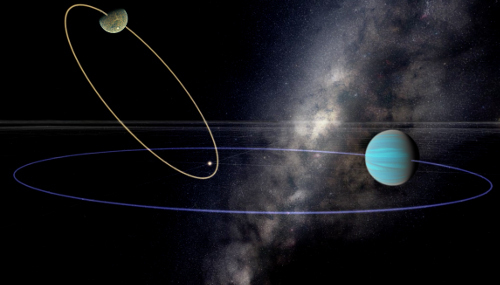
Image: A “chaotic Earth” could exist in a planetary system in which a neighboring planet has a “year” that is an integer multiple of another planet’s “year,” and if the orbital planes are not aligned. The affected planet’s orbit can become very elongated and can even flip all the way over, so that the two planets are revolving in opposite ways. These planets would have unpredictable climates, perhaps becoming inhospitable for millions of years at a time. Here, the potentially habitable planet is perturbed by a Neptune-mass planet on a three-year orbit and has an elongated orbit, which would make it relatively hot. As such it is mostly dry, but some seas remain, including one which contains the stellar glint, a feature astronomers will look for as it reveals the presence of surface liquids. Credit: Rory Barnes.
In the new paper, Barnes discusses computer simulations his team performed to simulate planetary systems with resonance and mutually inclined orbits. The results are not kind to the prospects for astrobiology, for dramatic orbital fluctuations can occur, including planets being pushed into near-collisions with the host star. The researchers demonstrate the characteristics of planets in inclined MMRs and also discuss four worlds known to be in MMRs but whose inclination is not known: HD 128311 and HD 73426 (2:1 resonance), HD 60532 (3:1) and HD 45364 (3:2). Inclined MMR systems are found to evolve chaotically for at least 10 billion years.
The authors liken what happens to planets in this configuration to a pendulum:
We have simulated the orbital evolution of exoplanets in mean motion resonances and inclinations and found the orbits can evolve chaotically for at least 10 Gyr. We hypothesize that these systems behave like compound pendula, which are naturally chaotic systems that can switch between modes of oscillation, as seen in our simulations… We find this chaotic motion over a range of mass ratios and for the 2:1, 3:2 and 3:1 resonance. We also tested different N-body codes using different integration schemes, and conclude the results are robust. Inclined MMRs can be produced by planet-planet scattering and the resultant systems are qualitatively similar to our simulations of known systems in an MMR.
We learn from these simulations that inclined MMR systems can produce planets in short-period orbits misaligned with the spin axis of the host star. We also learn that planets in mean mutual resonance may episodically go through periods of migration inward toward the star. The argument is that if we are looking for potentially habitable planets, we should consider that systems with MMRs and mutual inclination may be in a state of chaotic evolution where habitable conditions on a particular world will not be maintained long enough for life to emerge.
The results were something of a surprise for the researchers, as Barnes notes in this UWA news release:
“What happens when you have planets that are in this resonance and with mutual inclinations? … [W]hat we found was that things go all haywire. Those little perturbations that keep happening at the same point cause one of the orbits to do some crazy things — even flip over entirely — and then kind of come back to where it was before. It was pretty unexpected for us.”
These potential effects are all shown through simulation, as we have no examples of planets that are known to be in both mean mutual resonance as well as mutually inclined orbits. The authors believe the best way to detect such systems is through astrometric measurements, since identification through transits or radial velocity methods is difficult. The paper suggests that the European Space Agency’s Gaia instrument is the most likely to discover inclined MMRs through astrometry, offering us an observational test of these theories on chaotic orbital evolution.
The paper is Barnes et al., “Long-lived Chaotic Orbital Evolution of Exoplanets in Mean Motion Resonances with Mutual Inclinations,” accepted for publication in The Astrophysical Journal (preprint).





Paul Gilster's Blog
- Paul Gilster's profile
- 7 followers


